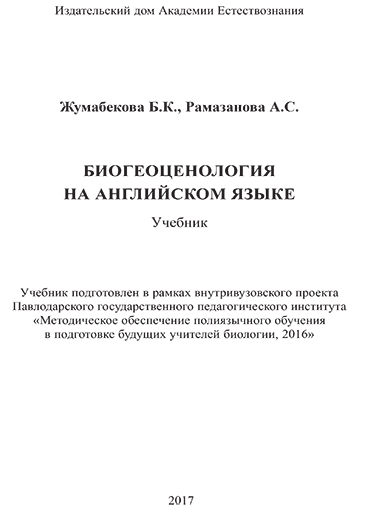
Научная электронная библиотека
Монографии, изданные в издательстве Российской Академии Естествознания
Chapter 12. KAZAKHSTAN NATURAL RESERVES AND NATIONAL PARKS
|
Essential targets: By the end of this chapter you should be able to answer the following questions: What is the Nature reserve? What types of reserves are there in Kazakhstan? What are the functions of the National parks? |
Read the text and make a flowchart / Мәтінді оқып шығыңдар және блок-сызба құрастырыңдар / Прочитайте текст и составьте блок-схему.
Nature reserve, area set aside for the purpose of preserving certain animals, plants, or both. A nature reserve differs from a national park usually in being smaller and having as its sole purpose the protection of nature [1].
Kazakhstan’s natural environment enjoys state protection of a variety of kinds. The commonest form is status either as a nature reserve or as a national park, but there are other categories, including nature park, arboreal park, reserved area and game reserve. Nature reserves, of which there are ten in the Republic, are territories enjoying the highest level of protection. This status is conferred to protect unique environments inhabited by rare and endangered species of flora and fauna [2].
Aksu-Zhabagly is the oldest reserve in Kazakhstan, established originally in 1926 and now possessing UNESCO biosphere reserve status. Situated in South Kazakhstan oblast, the reserve covers an area of 85,700 hectares, home to such rare and endangered species as Tien Shan brown bear, snow leopard, argali and several types of falcon and eagle. Maidenhair fern, Greig’s tulip, water-lily tulip, Juno coerulea and other rare species grow there (Photo 8) [2].
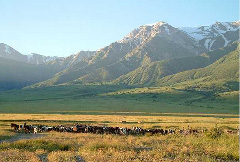
Photo 8. Aksu-Zhabagly [3]
The Korgalzhyn is the largest preserve zone in Kazakhstan, and occupies an area of about 258.9 million hectares and including 198,000 hectares of wetlands (Photo 9).
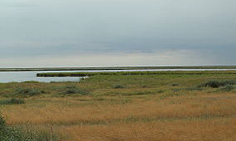
Photo 9. Korgalzhyn [5]
Korgalzhyn nature reserve was established on the territory of Akmola and Karaganda oblasts to protect rare and endangered marshland and swimming birds. Fauna found here include kovylok, spoon-bill, glossy ibis, black stork, whooper swan, red-breasted goose and houbara bustard; among the flora are Schrenk’s tulip, blue onion, Ural liquorice, marshmallow and Levant wormseed. The reserve is home to the northernmost population of pink flamingo [4].
Alakol nature reserve, covering an area of 17,400 hectares, is situated in Almaty and East Kazakhstan oblasts. The emphasis here is on the protection of certain birds and fish, including, in Lake Alalkol, a thriving population of Balkhash perch, an otherwise rare fish endemic to Kazakhstan. Another notable inhabitant of Alakol is the extremely rare relic gull (Larus relictus) (Photo 10) [2].

Photo 10. Alakol lake [7]
Markakol National Reserve. Eastern Kazakhstan shelters one of the most surprising corners of Kazakhstan – the Markakol National Reserve. Lake Markakol is justly called the pearl of this area (Photo 11). Markakol nature reserve occupies 75,000 hectares in Kurchum district of East Kazakhstan oblast. Fish species of the salmon family endemic to its unique mountain lake include lenok, grayling and salmon trout. Brown bear, sable, erne, golden eagle and Altai snowcock live in its forests. Important plant species here include maral root, anomalous peony, steppe peony and rhodiola rosea [8].
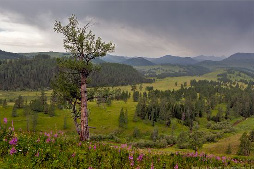
Photo 11. Markakol National Reserve [9]
The Naurzum Reserve is situated on the territory of the Naurzum and Semiozyorski regions of Kostanay Oblast, 190 km to the south of Kostanay, in the Turgay Narrows, where the Tersek, the Sipsin and the Naurzum Tracts join (Photo 12). Naurzum nature reserve, occupying 87,600 hectares was set up to protect the unique coniferous forest there. Rare and endangered fauna here include saker falcon, golden eagle, demoiselle crane, grey crane, swan, and imperial eagle; important flora include Kirgiz birch and Shrenk’s tulip [10].
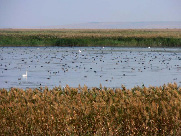
Photo 12. Naurzum [11]
West Altay State Nature Reserve was organized in 1992 and covers an area of 56.3 hectares (Photo 13).
In the origins of White Uba river there are 14 small glaciers and above the forest located small mountain glacial lakes and swamps, giving rise to streams. Here several climatic zones are next to each other at the same time – taiga coniferous forests, alpine meadows and alpine tundra. And all of this is adjacent to each other, creating the slopes incredible beauty of hardwood and pine-fir green belts [11].
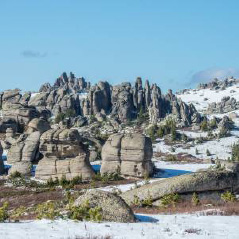
Photo 13. West – Altai National Reserve [11]
Ustyurt National Biosphere Reserve. One of the most attractive tourist routes in the territory of the preserve is the Journey Along the Great Silk Road. This is the spot where the trans-shipment of cargo from land to sea and vice versa was performed (Photo 14). Ustyurt nature reserve, spread over 223,300 hectares in Mangystau oblast, protects, among others, the Afghan red sheep and the saiga [2].
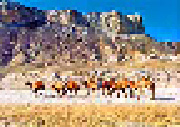
Photo 14. Ustyurt National Biosphere Reserve [2]
Almaty nature reserve, in the Zailyiiskii Alatau mountains of Almaty oblast, covers an area of 71,700 hectares. Rare and endangered fauna to be found here include ibisbill, golden eagle, lammergeyer, Turkestani lynx, snow leopard and Alpine ibex. Edelweiss grow here (Photo 15) [12].
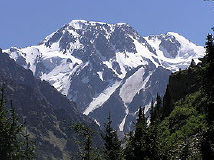
Photo 15. Peak Talgar in Almaty nature reserve [12]
Barsakelmes nature reserve occupies 30,000 hectares on Barsakelmes Island in the Aral Sea. It was established to protect and support the koulan, an endangered equine species. Saiga and goitered gazelle share the reserve with the koulan. The rare shrub black saxaul grows here (Photo 16) [13].
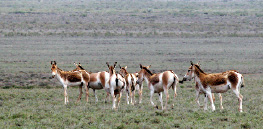
Photo 16. Koulans in Barsakelmes nature reserve [13]
Karatau nature reserve, covering 34,300 hectares of South Kazakhstan oblast, was established to protect and foster local flora and fauna including the Karatau argali and the Sogdian ash. The re-introduction of brown bear, koulan and snow leopard, all of which used to inhabit this area, is planned (Photo 17) [2].

Photo 17. Karatau argali [2]
National parks. The function of the national parks is to protect, restore and exploit natural and historic objects of special ecological, scientific and recreational significance - they protect unique natural environments that serve also as tourist resorts. Restrictions in national parks are less exacting than those in nature reserves, with the exception of certain areas within them where nature reserve regulations apply. The national parks are generally easy of access, although sometimes there is an entrance fee. Economic activity is forbidden in national parks, although hunting is in some cases permitted if a hunting licence, which can be expensive, has been obtained.
The nine main national parks in Kazakhstan are at Ile-Alatau, Charyn, Kolsai-Kolderi and Altyn-Emel in Almaty oblast; Bayanaul in Pavlodar Oblast; Kokshetau in Akmola and North Kazakhstan oblasts; Karkaraly in Karaganda oblast; Katon-Karagai in East Kazakhstan oblast; and Sairam-Ugam in South Kazakhstan oblast [14].
Glossary of essential terms / Негізгі терминдер глоссарийі / Глоссарий основных терминов
|
№ |
English term |
Kazakh equivalent |
Russian equivalent |
|
1 |
border |
шекара |
граница |
|
2 |
coast |
жағалау |
побережье |
|
3 |
gorge |
аңғар |
ущелье |
|
4 |
hunter |
аңшы |
охотник |
|
5 |
impetuous |
екпінді |
стремительный |
|
6 |
mountain |
тау |
гора |
|
7 |
ravine |
жыра |
овраг |
|
8 |
route |
бағдар |
маршрут |
|
9 |
vice versa |
керісінше |
наоборот |
|
10 |
waterfall |
құлама |
водопад |
|
Questions: What are the functions of Nature reserve? What is the difference between the reserve and the national park? What do you know about Kazakhstan Nature reserves? |
|
Key phrases and sentences / Түйінді сөздер мен сөйлемдер / Ключевые фразы и предложения 1. A nature reserve is …/ Қорық дегеніміз .../ Заповедник это … 2. A nature reserve is importance for …/ Қорық … үшін маңызды болып табылады …/ Заповедник имеет важное значение для … 3. Nature reserves may be designated by …or …/ Қорықтар … немесе … тағайындалады/ Заповедники могут быть назначены …или … |
I. True or False / Шын немесе жалған / Правда или Ложь.
1. Nature reserve is area set aside for the purpose of preserving certain animals, plants, or both.
2. The most prominent species of Alakol nature reserve are the snow leopard.
3. The main constituent of the Korgalzhyn National Park is wetlands.
4. The Naurzum Reserve is located in the central part of Turgai Plateau within the steppe zone of Kazakhstan.
5. Ustyurt National Biosphere Reserve consists a unique feature within the southern steppe zone, forests. These forests are composed mainly of pine, birch and aspen.
6. The temperature in the territory of the Almaty nature reserve is mainly hot and dry.
7. Western-Altai nature reserve is located in Rudny Altai, and presents various types of taiga complexes - black taiga, cedar fir and dark coniferous woods.
8. The Markakol nature reserve was founded with the purpose to preserve the nature of the central part of Zailiy Alatau, as well as the species of fauna and flora of this region.
9. Barsa-Kelmes Nature Reserve is the former island in the Aral Sea.
10. In total about 30 species of mammals, including three Red booked – Karatau mountain ram, a stone marten and a porcupine are registered in Karatau nature reserve. The predatory birds are especially remarkable: a saker falcon, a golden eagle, an Egyptian vulture, an eagle-dwarf, a serpent eagle and bearded vulture which are included in the Red book of Kazakhstan.
II. Translate into English and Kazakh / Ағылшын және қазақ тілдеріне аударыңдар / Переведите на английский и казахский языки.
Заказник – участок территории или акватории, в пределах которого постоянно или временно запрещены отдельные формы хозяйственной деятельности для обеспечения охраны определенных видов живых существ, отдельных биогеоценозов, экологических компонентов, пейзажа в целом и других природных достопримечательностей.
III. Make a list of nature reserves in your area and describe them / Өз аймақтарыңның қорықтарын атап шығыңдар, оларға сипаттама беріңдер / Перечислите заповедники вашего региона, охарактеризуйте их.
IV. Prepare a poster on the topic «Nature Reserves of Kazakhstan» / «Қазақстан қорықтары» тақырыбына стендті баяндама дайындаңдар / Подготовьте стендовый доклад на тему «Заповедники Казахстана».
V. Imagine that you are a guide in the one of nature reserves of Kazakhstan. Spend a virtual tour for students around of the reserve / Қазақстан қорықтарының бірінде Сіз жолбасшы делік. Қорық бойынша студенттерге арналған виртуалды топсеруен жүргізіңіз / Представьте, что Вы гид в одном из заповедников Казахстана. Проведите виртуальную экскурсию для студентов по заповеднику.
|
SUMMARY A nature reserve is a protected area of importance for wildlife, flora, fauna, which is reserved and managed for conservation and to provide special opportunities for study or research. The main nature reserves in Kazakhstan are Aksu-Zhabagly, Korgalzhyn, Alakol, Markakol, Naurzum, Ustyurt, Barsakelmes, Karatau, West-Altai National Reserve and Almaty nature reserve. National park is an area of land that is owned and protected by a national government because of its natural beauty or its importance to history or science. |
 Topics for essay:
Topics for essay:
1. Botanic gardens of Kazakhstan.
2. Zoological gardens of Kazakhstan.
3. Endemic plants on the territory of Kazakhstan.
4. Endemic animals on the territory of Kazakhstan.
5. Animals which listed in the Red book of Kazakhstan.
6. Plants which listed in the Red book of Kazakhstan.
7. Protection of flora and fauna of Kazakhstan.
8. A relict (or relic) plants of Kazakhstan.
9. A relict (or relic) animals of Kazakhstan.
10. Endemic plants and animals on the territory of Australia.
 References:
References:
1. Encyclopedia Britannica // http://www.britannica.com/EBchecked/topic/406581/nature-reserve
2. Discovery // http://www.discovery-kazakhstan.com/archive/2008/10_ 5.php
3. Aksu-Zhabagly // http://caravanistan.com/places/aksu-zhabagly/
4. https://en.wikipedia.org/wiki/Korgalzhyn_Nature_Reserve
5. Korgalzhyn Nature Reserve // http://www.kazakhstan.orexca.com/korgalzhyn_reserve_kazakhstan.shtml
6. Tengri News // https://en.tengrinews.kz/environment/Alakol-enters-global-network-of-biosphere-reservations-19926/
7. Markakol // http://www.kazakhstan.orexca.com/markakolskiy_reserve_ kazakhstan.shtml
8. Markakolsky State Nature Reserve // http://aboutkazakhstan.com/blog/nature/markakolsky-state-nature-reserve/
9. Advant // http://www.advantour.com/kazakhstan/northern/naurzym-reserve.htm
10. Art // http://art-sheep.com/15-most-breathtaking-world-heritage-sites-2/
11. West altay state nature reserve // http://kazakhstan.travel/en/attractions/ attraction/930
12. http://www.kazakhstan.orexca.com/ustyurt_reserve_kazakhstan.shtml
13. http://www.unikaz.asia/ru/content/chudo-zapovednika-barsakelmes
LABORATORY WORK 4
The theme: SPECIES BIODIVERSITY LAB (Developed by E. A. Betts).
The aim: To understand the importance of biodiversity, calculate the indices of the Simpson’s Index, and quantify the biodiversity of a sample.
Background Information
Simpson’s Diversity Index is a measure of diversity. In ecology, it is often used to quantify the biodiversity of a habitat. It takes into account the number of species present, as well as the abundance of each species. Before looking at Simpson’s Diversity Index in more detail, it is important to understand the basic concepts. Biological diversity can be quantified in many different ways. The two main factors taken into account when measuring diversity are richness and evenness. Richness is a measure of the number of different kinds of organisms present in a particular area. For example, species richness is the number of different species present. However, diversity depends not only on richness, but also on evenness. Evenness compares the similarity of the population size of each of the species present. Richness - The number of species per sample is a measure of richness. The more species present in a sample, the ‘richer’ the sample. Species richness as a measure on its own takes no account of the number of individuals of each species present. It gives as much weight to those species which have very few individuals as to those which have many individuals. Thus, one daisy has as much influence on the richness of an area as 1000 buttercups. Evenness - Evenness is a measure of the relative abundance of the different species that make up the richness of an area. To give an example, we might have sampled two different fields for wildflowers. The sample from the first field consists of 300 daisies, 335 dandelions and 365 buttercups. The sample from the second field comprises 20 daisies, 49 dandelions and 931 buttercups (see the table below). Both samples have the same richness (3 species) and the same total number of individuals (1000). However, the first sample has more evenness than the second. This is because the total number of individuals in the sample is quite evenly distributed between the three species. In the second sample, most of the individuals are buttercups, with only a few daisies and dandelions present. Sample 2 is therefore considered to be less diverse than sample 1.
Table 1. The number of Flower Species in the different fields
|
Flower Species |
Individuals in Sample #1 |
Individuals in Sample #2 |
|
Daisy |
300 |
20 |
|
Dandelion |
335 |
49 |
|
Buttercup |
365 |
931 |
|
Total |
1000 |
1000 |
Simpson’s Index (D) measures the probability that two individuals randomly selected from a sample will belong to the same species (or some category other than species). There are two versions of the formula for calculating D. In this class we will use the following.

Where ni is the number of each individual species, N is the total number of individuals, and D ranges between 0 and 1. With this index, 0 represents infinite diversity and 1, no diversity. That is, the bigger the value of D, the lower the diversity.
Procedure:
1. Using a small net, take a bottom sample from the simulated waterbody. Empty the sample and inventory the different “species” and the abundance of each species in the sample.
Site 1
|
«Species» |
Number |
Site 2
|
«Species» |
Number |
Site 3
|
«Species» |
Number |
Site 4
|
«Species» |
Number |
2. Use the data to calculate the Simpson diversity index for each sample.
|
Site |
Simpson Diversity Index |
|
Site 1 |
|
|
Site 2 |
|
|
Site 3 |
|
|
Site 4 |
3. Which site had the greatest amount of biodiversity?
4. Which site had the least?
5. Which “species” were present and abundant at every site?
6. Which “species” were only found at certain sites?
7. Why do you think some species were not found at all sites? What could have caused their disappearance from the site?
8. What were some problems or errors associated with the simulation?
9. Make a conclusion of results your work.
References:
1. Science in the park: rock pools // http://www.jamesriverpark.org/science-in-the-park/rock-pools/SpeciesBiodiversityLab.pdf
TOPICS OF SEMINAR
Seminar 10
Chapter 10. A variety of ecosystems.
1. Ecosystem as a complex of the biogeocenosises.
2. Ecosystems in temperate zones.
3. Ecosystems in the tropics.
4. Marine ecosystems.
Seminar 11
Chapter 11. Biodiversity, its monitoring and protection.
1. Different definitions of term “Biodiversity”.
2. Types of biodiversity.
3. The biodiversity monitoring.
4. The important of biodiversity.
Seminar 12
Chapter 12. Kazakhstan natural reserves and national parks
1. Kazakhstan’s policy on nature protection.
2. Kazakhstan natural reserves.
3. Kazakhstan natural parks.
4. Foreign experience in the creation of nature reserves.
Recommended references:
1. The ecosystem concept / http://www.ecosystems.ws/ecosystem_concept.htm
2. What is a national park? / http://www.environment.nsw.gov.au/edresources/ WhatIsANationalPark.htm
3. Marine ecosystems / http://www.eu-hermione.net/learning/marine-eco systems
4. Why Is Biodiversity Important? / http://www.globalissues.org/article/170/ why-is-biodiversity-important-who-cares
5. Biodiversity & Human Well-being / http://www.greenfacts.org/en/biodiversity/l-3/1-define-biodiversity.htm
6. The main conditions for the implementation of the environmental policy /http://enrin.grida.no/htmls/kazahst/soe2/soee/nav/info/ecopol.htm
7. The Law of the Republic of Kazakhstan on environmental protection/ http://www.climate.kz/eng/?m=html&cid=46
TASKS FOR THE CONTROL WORK 4
Solve the crossword.
Across
2. Shoreline area along ocean where water rises and falls
3. Freshwater wetland with lots of woody plants such as cypress trees
6. Area of the ocean rich with life found above the continental shelf
8. When many animals are active and plant stomata are open in hot desert organisms
9. one of the largest wetlands in the U.S. located in Florida
12. Large climatic regions containing several related ecosystems
14. Freshwater wetland with lots of cattails and other nonwoody plants
15. Type of forest with primarily pines, cedars, spruce, and fir cone-bearing trees
17. Ocean bottom
19. Permanently frozen layer of soil
21. State in the U.S. with chaparrals
25. A continuous layer formed by treetops
26. Cold Asian desert
30. Ecosystem with long wet seasons and year-round growing plants
31. Tall herbivore found on a savanna
32. Type of forest ecosystem with primarily plants that lose their leaves each year
33. Area at the mouth of a river where freshwater and ocean water meet
34. Type of ecosystem with moderate climate and distinct seasons
35. Small plants that live on the branches of trees in order to get enough sunlight
Down
1. Microscopic organisms in water ecosystems that start many food chains
4. Common animal hunted in deciduous forests
5. Cold ecosystem with few if any trees and covered with a layer of permafrost
7. Tropical grassland in Africa, South America, and Australia
10. Large desert cactus in U.S. deserts that stores large amounts of water and has spines instead of leaves
11. Photosynthetic area of the ocean
13. Temperate grassland, subject to periodic fires, with spiny shrubs and clumps of conifers
16. Zone of the ocean beyond the continental shelf
17. A colorful bird found in tropical rain forests
18. Type of ecosystem in which we live
20. Intense competition for this abiotic factor exists in jungles
21. Form in the neritic zone of tropical ocean waters and provide a home for many other organisms
22. Cold dark area of the ocean where sunlight doesn’t penetrate
23. Freshwater ecosystem rich with organic matter and vegetation
24. Ecosystem located south of the tundra where many animals hibernate or migrate during winter
27. Freshwater wetland with lots of sphagnum moss
28. Freshwater ecosystem that is usually clear and contains little organic matter
29. An animal found in tundras
ECOSYSTEMS

